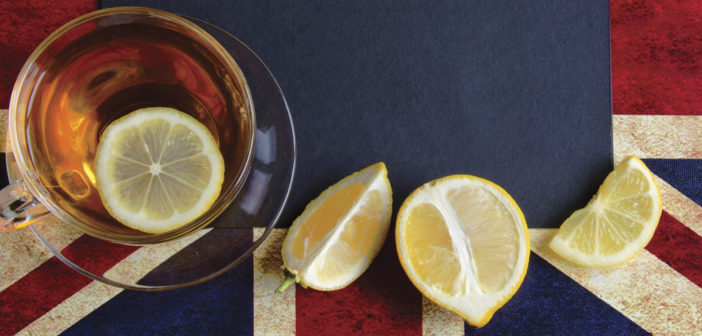What comes to mind when hearing or reading the words “afternoon tea?” Is it crisp, white tablecloths and delicate, bone china dishes, scones and jams and pinkies sticking out just so? Is it something more casual, perhaps? Just cups of hot brew with a little cream, shared at a table to help keep your eyes open mid-day? Or maybe it’s fancier still, with tiny triangles of cucumber sandwiches and Coronation Chicken, trifles of Battenberg cakes and macaroons all set upon three tiers of perfectly assembled wonder.
For me, growing up, afternoon tea was simply a pot of tea shared with my grandmother. We’d pour cups of green tea, Constant Comment or Earl Grey and talk. She’d tell me stories, some from her life, some she made up, and we’d sip. That was it. But from that humble beginning, a fascination with the idea of afternoon tea began. I’d read about the “posher” variety in novels, I’d see it in period films, and I even partook of an especially lovely version once in North Carolina.
But then, we visited England, and our notion of afternoon tea was turned on its head – and I was ruined forever.
On our first trip to England, we were slated to visit London, Bath and Manchester. We had tea scheduled in every city. The second time we visited, we had tea in the Lake District, in North Yorkshire and in York. The best, the fanciest, the most posh and unforgettable? London, of course.
In England, afternoon tea can be any of the ideas above. It can be a small meal, sweet treats, scones and jam – and of course, always, tea. It can be tea in bags (though this is frowned upon) or loose-leaf and listed on a fancy menu as fine wine would be. The menu will mention the plantation the leaves were grown on, the specific aromas, whether the tea is invigorating, sensual, calming or good for the complexion. And the tea we enjoyed in London had this type of menu, along with a menu of complementary champagnes, cocktails and other refreshments to pair with the tea. At this establishment, it wasn’t simply tea – it was an event.
Being American, I think we were more in awe of the menu and presentation than the other customers were. Eggs in egg cups, tiny sandwiches with sprouts, salmon, cucumbers and all kinds of strange toppings we’d never order on purpose. Tiny cheese in pastry and all sorts of desserts, from pink marshmallows tied into knots to miniature, pink teacakes that looked too perfect to eat. The champagne corks popped almost as often as the teacups clinked into their delicate saucers, but the conversation never rose above a polite hum.
This experience far surpassed what I had imagined, but it wasn’t the old-fashioned decadence of novels nor the stuffy etiquette of period films. Instead it was something … modern. Decadent, yes – but pompous, no. It was as if all the fun of afternoon tea had been modernized, all the elegance made accessible, especially for us Yankee Doodles who wouldn’t know the correct position for our pinkies and could barely keep our elbows off the table.
This was a far cry from my grandmother’s table: two mugs filled with whatever tea variety had caught her eye at the grocery store, a cotton tablecloth, a plain creamer and some sugar spilled on the table. But, the feeling for both was mostly the same.
This is afternoon tea, then. Just a pause in a hectic day, and no matter how many tiny sandwiches or how much clotted cream is placed on the table, it’s the pause that matters. That – and the champagne, of course.















1 Comment
After reading your delightful description of tea in London, I think I should put it on my bucket list. Recalled memories of the elaborate dessert trays when we were in France. P.S. If I make it to London, I’ll try to remember I’m in the land of royalty, keep my elbows off the table, and keep my pinky just so.